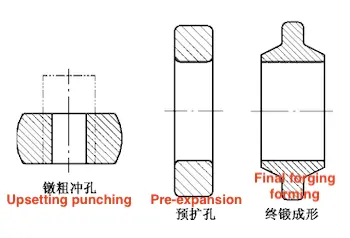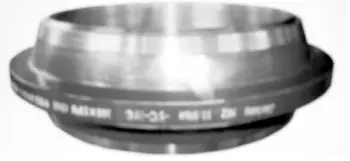Forming and Manufacturing Technology of Anchor Flanges
On this page
An anchor flange is a key component in large-diameter, high-pressure, long-distance gas (oil) pipeline systems. This paper presents independent research and development work on the production technology of large anchor flanges. The structural parameter design was conducted by combining theoretical calculations with finite element numerical simulation technology. The improved CF62 steel was selected as the material for the anchor flange. A variety of advanced and practical forming and manufacturing schemes were proposed. A batch of domestic products was manufactured using rotary forging expansion technology to meet the urgent needs of major national projects in China.
An anchor flange is an important supporting component with complex stress, and the quality requirements are extremely stringent. Plastic forming and heat treatment are two key aspects of manufacturing technology. Only through sufficient plastic deformation and proper heat treatment can the internal structure be dense, the grains fine and uniform, and the distribution reasonable to meet performance requirements. In addition, the hot working process significantly impacts material and energy savings, reducing defects, defective products, and costs. The following process plan is formulated based on the current state of hot working equipment.
An anchor flange is an important supporting component with complex stress, and the quality requirements are extremely stringent. Plastic forming and heat treatment are two key aspects of manufacturing technology. Only through sufficient plastic deformation and proper heat treatment can the internal structure be dense, the grains fine and uniform, and the distribution reasonable to meet performance requirements. In addition, the hot working process significantly impacts material and energy savings, reducing defects, defective products, and costs. The following process plan is formulated based on the current state of hot working equipment.
3.1 Rotary Forging Hole Expansion
The anchor flange is large and complex in shape. Ring rolling forming requires a large ring rolling machine. The material transfer is significant when rolling the high-necked large flanges at both ends. Ring rolling technology and tooling manufacturing present certain difficulties. In this case, the rotary forging hole expansion method is adopted. Rotary forging hole expansion is characterized by good forging permeability, labor efficiency, simple tooling, and ease of operation. However, forging hole expansion is a non-steady-state local forming process, and deformation can be uneven. To overcome these shortcomings, several measures are adopted. The key is to scientifically and precisely control thermodynamic parameters, such as managing the deformation temperature range, regulating pressure reduction, and ensuring quick and even rotation. With sufficient deformation and proper control of thermal parameters, satisfactory forging quality can be achieved. To save raw materials, the flange edge can be forged. The grooved upper anvil-mandrel hole expansion method can be used for forging, or the pre-expanded billet can be placed on a flat anvil, forging the flange edge while rotating with a rotating device. Practice has proven that by carefully controlling deformation temperature, speed, degree, and proper matching, strain remains uniformly distributed, and qualified products can be forged at the appropriate forging temperature. This is currently the most suitable forming method.
3.2 Rolling
This scheme can be applied when installing a large ring rolling machine and during mass production. This method offers extremely high productivity and minimal processing allowance. If thermodynamic parameters are properly controlled, controlled rolling and cooling can be implemented to enhance the structure and performance, further improving the quality. This is the subsequent development method.

Figure 3 Forming process of anchor flanges

Figure 3 Forming process of anchor flanges
3.3 Casting and Forging (Rolling) Combined Forming
The processes of casting and forging are combined to utilize complementary forming mechanisms, manufacturing products more efficiently and effectively. Since casting easily produces complex shapes, and forging and rolling significantly improve internal structure and performance, combining their complementary advantages enhances efficiency and quality. For rings, the ingot can be produced by centrifugal casting, electroslag casting, or medium frequency casting, followed by a short period of uniform heating, after which it is rolled (or forged) into shape. This solution features a short process flow, high efficiency, energy savings (low heat consumption), material savings, and low cost. With proper control of the hot forming process parameters, production goals of high quality, high efficiency, and low cost can be achieved. In summary, controlled hot forming and short-process technology are advanced hot-processing methods that require further development and application.
3.4 Shape and Diameter Correction Technology
Due to various factors, the shape and size deviations of large rings are often significant during hot forming. They should be corrected before machining to reduce the processing allowance. The correction device can either be a mechanical wedge-expansion-type diameter correction device or a hydraulic transmission correction device.
3.5 Temperature Control and Power-Saving Heat Treatment
According to technical requirements, to ensure the comprehensive mechanical properties of the workpiece, the anchor flange should be tempered after forming. Since the electric furnace offers the best temperature control performance, it ensures the quality of the heat treatment. However, to reduce electricity consumption during periods of high demand, the workpiece can be preheated in a gas furnace first and then switched to an electric furnace for temperature control. This method not only saves electricity but also ensures the quality of the heat treatment.
4. Quality Inspection and Performance Test
After the anchor flange is made, multiple quality inspections, such as testing mechanical properties, examining the metallographic structure, conducting non-destructive testing, and performing color detection, are necessary to ensure the product's high quality. In addition, to ensure the safe and reliable use of the anchor flange, a pressure bending test is required, as shown in Figure 4.
The pressure bending test simulates the actual working conditions of the anchor flange, which must bear the internal pressure of the fluid while applying an equivalent axial thrust on the rim to detect deformation and leakage, evaluate performance, and ensure operational safety and reliability. However, during the test, due to the product's large diameter and the significant sealing force required, labor-saving measures can be employed to prevent additional bending deformation. The on-site application of this solution has proven effective and is worth promoting.

Figure 4 Pressure bending test
The pressure bending test simulates the actual working conditions of the anchor flange, which must bear the internal pressure of the fluid while applying an equivalent axial thrust on the rim to detect deformation and leakage, evaluate performance, and ensure operational safety and reliability. However, during the test, due to the product's large diameter and the significant sealing force required, labor-saving measures can be employed to prevent additional bending deformation. The on-site application of this solution has proven effective and is worth promoting.

Figure 4 Pressure bending test
5. Mechanical Processing, Anti-Corrosion and Packaging
According to technical requirements, the anchor flange must undergo rough machining and ultrasonic inspection before heat treatment. After forming and heat treatment, fine machining should be performed, including the precise machining of external dimensions and welding grooves, followed by necessary inspections. Anti-corrosion treatment should be applied before delivery to the user, and the product should be packaged and shipped to the site for welding with the pipeline. Figure 5 shows a photo of anchor flanges.

Figure 5 Anchor flanges

Figure 5 Anchor flanges
6. Conclusion
(1) By combining theoretical calculations with finite element numerical simulation technology and referring to practical production experience, more reasonable structural parameters were designed.
(2) Practice has proven that the improved CF62 steel can replace X70 steel for making anchor flanges, which not only meets performance and welding requirements but is also easy to smelt and manufacture, suitable for national conditions, and simple to produce.
(3) The rotary forging and hole expansion scheme is currently the most suitable anchor flange forming and manufacturing method. With continuous improvements in equipment and process technology, more advanced schemes will emerge.
(4) The pressure bending test is a practical inspection method and is worth promoting.
(2) Practice has proven that the improved CF62 steel can replace X70 steel for making anchor flanges, which not only meets performance and welding requirements but is also easy to smelt and manufacture, suitable for national conditions, and simple to produce.
(3) The rotary forging and hole expansion scheme is currently the most suitable anchor flange forming and manufacturing method. With continuous improvements in equipment and process technology, more advanced schemes will emerge.
(4) The pressure bending test is a practical inspection method and is worth promoting.
Related News
- Low-Temperature Flange Sealing Solutions for Cryogenic Chemical Pipelines
- Innovative Technology for Automatic Alignment in Underwater Flange Assembly
- Stamped Steel Slip-On Flanges
- Design and Finite Element Analysis of Anchor Flanges for Oil & Gas Pipelines
- Forming and Manufacturing Technology of Anchor Flanges
- Structure and Materials of Anchor Flanges
- Flanges for Pressure Vessels
- An Introduction to Socket Welded Neck Flanges
- Heat Treatment & Mechanical Properties of ASTM A350 LF3 Flanges (Part Two)
- Heat Treatment & Mechanical Properties of ASTM A350 LF3 Flanges (Part One)
